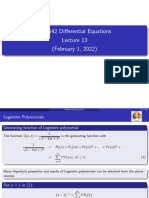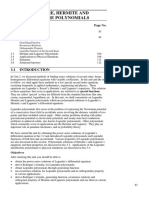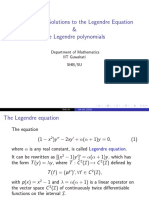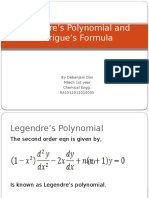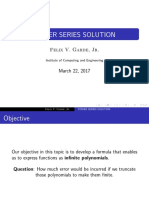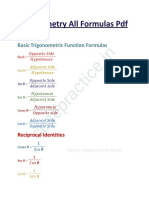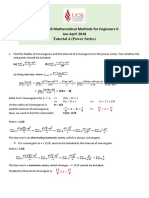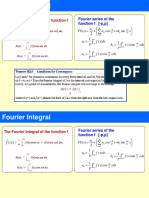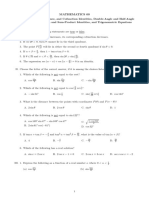Created by T.
Madas
LEGENDRE’S
EQUATION
including Legendre’s functions and Legendre’s polynomials
Created by T. Madas
� Created by T. Madas
Summary on Legendre Functions/Polynomials
Legendre’s Differential Equation
d2y
(
1 − x2 ) dx2 − 2 x dydx + n ( n − 1) y = 0 , n∈ℝ.
General Solution of Legendre’s Differential Equation
( n + 1) n x2 + ( n + 3)( n + 1) n ( n − 2) x4 − ( n + 5)( n + 3)( n + 1) n ( n − 2)( n − 4) x6 + ...
y = A 1−
2! 4! 6!
+
( n + 2)( n − 1) 3 ( n + 4)( n + 2)( n − 1)( n − 3) 5 ( n + 6)( n + 4)( n + 2)( n − 1)( n − 3)( n − 5) 7
B x− x + x − x + ...
3! 3! 7!
• If n is an even integer, the first solution terminates after a finite number of
terms, while the second one produces an infinite series.
• If n is an odd integer, the second solution terminates after a finite number of
terms, while the first solution produces an infinite series.
• The finite solutions are the Legendre Polynomials, also known as solutions of
the first kind, denoted by Pn ( x ) .
• The infinite series solutions are known as solutions of the second kind,
denoted by Qn ( x ) .
The second solution Qn ( x ) can be written in terms of Pn ( x ) by
∫(
1
Qn ( x ) = Pn ( x ) dx
1− x 2
) ( Pn ( x )) 2
Created by T. Madas
� Created by T. Madas
The infinite series form for the Legendre’s polynomial Pn ( x ) is given by
N
Pn ( x ) =
∑
k =0
n
( 2 n − 2k )!
2 k ! ( n − k )!( n − 2k )!
( −1)k x n−2k ,
where N is the floor function
1n if n is even
2
N =
1 ( n − 1) if n is odd
2
The generating function for the Legendre’s polynomial Pn ( x ) is given by
∑
1
2 −2
(1 − 2 xt + t ) = t n Pn ( x )
n =0
Created by T. Madas
� Created by T. Madas
Question 1
Find the two independent solutions of Legendre’s equation
2
(1 − x2 ) ddx2y − 2 x dydx + n ( n + 1) y = 0 , n ∈ ℝ .
( n + 1) n x2 + ( n + 3)( n + 1) n ( n − 2) x4 − ( n + 5)( n + 3)( n + 1) n ( n − 2)( n − 4) x6 + ...
y = A 1−
2! 4! 6!
+
( n + 2)( n − 1) 3 ( n + 4)( n + 2)( n − 1)( n − 3) 5 ( n + 6)( n + 4)( n + 2)( n − 1)( n − 3)( n − 5) 7
B x− x + x − x + ...
3! 3! 7!
Created by T. Madas
� Created by T. Madas
Question 2
Legendre’s equation is given below
2
(1 − t 2 ) ddt w2 − 2t dw
dt
+ n ( n + 1) w = 0 , n ∈ ℕ .
a) By assuming a series solution of the form
∞
w ( t ) = ∑ ar t r , a0 ≠ 0 ,
r =0
show by a detailed method that
ar + 2 = −
( n − r )( n + r + 1) a .
( r + 2 )( r + 1) r
b) By rewriting the recurrence relation of part (a) backwards, and taking the
value of an as
n
( 2n − 2m + 1) ,
an =
∏
m =1
n!
show further that the Legendre’s polynomials Pn ( t ) can be written as
N
Pn ( t ) =
∑
k =0
n
( 2n − 2 k ) !
2 k ! ( n − k )!( n − 2k )!
( −1)k t n−2k ,
where N is the floor function
1n if n is even
2
N =
1 ( n − 1) if n is odd
2
proof
[ solution overleaf ]
Created by T. Madas
�Created by T. Madas
Created by T. Madas
� Created by T. Madas
Question 3
It can be shown that the Legendre’s polynomials Pn ( x ) can be written as
N
Pn ( x ) =
∑k =0
n
( 2 n − 2k )!
2 k ! ( n − k )!( n − 2k )!
( −1)k x n−2k ,
where N is the floor function
1n if n is even
2
N =
1 ( n − 1) if n is odd
2
Show that the generating function for Pn ( x ) satisfies
∑
1
2 −2
(1 − 2 xt + t ) = t n Pn ( x ) .
n =0
proof
Created by T. Madas
� Created by T. Madas
Question 4
The generating function for the Legendre’s polynomials Pn ( x ) , satisfies
∑
1
2 −2
(1 − 2 xt + t ) = t n Pn ( x ) .
n =0
Use this relationship to prove that
n
Pn ( − x ) = ( −1) Pn ( x ) .
MM3-D , proof
Created by T. Madas
� Created by T. Madas
Question 5
The generating function g ( x, t ) for the Legendre’s polynomials Pn ( x ) , satisfies
∑
1
2 −2
(
g ( x, t ) = 1 − 2 xt + t ) = t n Pn ( x ) .
n =0
Use this relationship to prove that
∂ ∂ 3
g ( x, t ) + g ( x, t ) = x g ( x, t ) .
∂x ∂t
MM3-E , proof
Created by T. Madas
� Created by T. Madas
Question 6
f ( x ) ≡ 10 x3 − 3 x 2 + x − 1 .
Express f ( x ) as a linear combination of Legendre’s polynomials, Pn ( x ) .
You may assume
• P0 ( x ) = 1
• P1 ( x ) = x
•
2 ( )
P2 ( x ) = 1 3x 2 − 1
• P3 ( x ) = 1 ( 5 x3 − 3 x ) ,
2
• P4 ( x ) = 1 ( 35 x 4 − 30 x 2 + 3)
8
f ( x ) = 4 P3 ( x ) − 2 P2 ( x ) + 7 P1 ( x ) − 2 P0 ( x )
Created by T. Madas
� Created by T. Madas
Question 7
The generating function for the Legendre’s polynomials Pn ( x ) , satisfies
∑
1
2 −2
(1 − 2 xt + t ) = t n Pn ( x ) .
n =0
By differentiating the above relationship with respect to t , prove that
( 2n + 1) x Pn ( x ) − ( n + 1) Pn+1 ( x ) + n Pn−1 ( x ) = 0 .
MM3-C , proof
Created by T. Madas
� Created by T. Madas
Question 8
The generating function for the Legendre’s polynomials Pn ( x ) , satisfies
∑
1
2 −2
(1 − 2 xt + t ) = t n Pn ( x ) .
n =0
By separately differentiating the above relationship once with respect to t and once
with respect to x , prove that
n Pn ( x ) = x Pn′ ( x ) − Pn′−1 ( x ) .
MM3-B , proof
Created by T. Madas
� Created by T. Madas
Question 9
The generating function for the Legendre’s polynomials Pn ( x ) , satisfies
∑
1
2 −2
(1 − 2 xt + t ) = t n Pn ( x ) .
n =0
a) Use this result to show that
Pn (1) = 1 .
b) By using the result of part (a) and Legendre’s equation, deduce that
Pn′ (1) = 1 n ( n + 1) .
2
MM3-A , proof
Created by T. Madas
� Created by T. Madas
Question 10
Use trigonometric identities to show that
sin 2 θ = 8 P4 ( cos θ ) − 16 P2 ( cos θ ) + 8 P0 ( cos θ )
35 21 15
You may assume
• P0 ( x ) = 1
• P1 ( x ) = x
•
2 ( )
P2 ( x ) = 1 3x 2 − 1
• P3 ( x ) = 1 ( 5 x3 − 3 x ) ,
2
• P4 ( x ) = 1 ( 35 x 4 − 30 x 2 + 3)
8
proof
Created by T. Madas
� Created by T. Madas
Question 11
The generating function g ( x, t ) for the Legendre’s polynomials Pn ( x ) , satisfies
∑
1
2 −2
(
g ( x, t ) = 1 − 2 xt + t ) = t n Pn ( x ) .
n =0
Verify that g = g ( x, t ) is a solution of the differential equation
∂2 ∂ ∂g
t
∂t 2 [t g ] + (
∂x
1 − x2 )
∂x
=0.
proof
Created by T. Madas
� Created by T. Madas
Question 12
The generating function for the Legendre’s polynomials Pn ( x ) , satisfies
∑
1
2 −2
(1 − 2 xt + t ) = t n Pn ( x ) .
n =0
a) Use this result to show that
n
Pn ( −1) = ( −1) .
b) By using the result of part (a) and Legendre’s equation, deduce that
n +1
Pn′ ( −1) = 1 n ( n + 1)( −1) .
2
MM3-A , proof
Created by T. Madas
� Created by T. Madas
Question 13
The Legendre’s polynomial Pn ( x ) is a solution of the differential equation
d2y
(1 − x2 ) dx2 − 2 x dydx + n ( n + 1) y = 0 , n∈ℝ.
Show that
x
n ( n + 1)
Pn′ ( x ) =
1 − x2 ∫
1
Pn ( x ) dx .
proof
Created by T. Madas
� Created by T. Madas
Question 14
The generating function for the Legendre’s polynomials Pn ( x ) , satisfies
∞
∑
1
2 −2
(1 − 2 xt + t ) = t n Pn ( x ) .
n =0
a) By differentiating the above relationship with respect to t , prove that
( 2n + 1) x Pn ( x ) = ( n + 1) Pn+1 ( x ) + n Pn−1 ( x ) .
b) By separately differentiating the generating function for the Legendre’s
polynomials once with respect to t and once with respect to x , prove that
n Pn ( x ) = x Pn′ ( x ) − Pn′−1 ( x ) .
c) Use parts (a) and (b) to show that
( 2n + 1) Pn ( x ) = Pn′+1 ( x ) + Pn′−1 ( x ) .
d) Use parts (b) and (c) to deduce that
( n + 1) Pn ( x ) = Pn′+1 ( x ) − x Pn′ ( x ) .
proof
Created by T. Madas
� Created by T. Madas
Question 15
The generating function for the Legendre’s polynomials Pn ( x ) , satisfies
∑
1
2 −2
(1 − 2 xt + t ) = t n Pn ( x ) .
n =0
Use this result to show that …
… if n is even, Pn ( x ) is an even polynomial in x .
… if n is odd, Pn ( x ) is an odd polynomial in x .
proof
Created by T. Madas
� Created by T. Madas
Question 16
The generating function for the Legendre’s Polynomials Pn ( x ) , satisfies
∑
1
2 −2
(1 − 2 xt + t ) = t n Pn ( x ) .
n =0
a) Use this result to show that
P2 n ( 0 ) =
( −1)n ( 2n )! .
22 n n !
b) Deduce the value of P2 n+1 ( 0 ) .
P2 n+1 ( 0 ) = 0
Created by T. Madas
� Created by T. Madas
Question 17
Legendre’s equation is given below
2
(1 − x2 ) ddx2y − 2 x dydx + n ( n + 1) y = 0 , n∈ℝ.
Use the substitution x = cos θ to show that
1 d dy
sin θ + n ( n + 1) y = 0 .
sin θ dθ dθ
proof
Created by T. Madas
� Created by T. Madas
Question 18
Find the two independent solutions of Legendre’s equation
2
(1 − x2 ) ddx2y − 2 x dydx + 2 y = 0 .
1 1+ x
y = Ax + B ln − 1
x 1− x
Created by T. Madas
� Created by T. Madas
Question 19
The generating function for the Legendre’s Polynomials Pn ( x ) , satisfies
∑
1
2 −2
(1 − 2 xt + t ) = t n Pn ( x ) .
n =0
Using this result, and integrating both sides with respect to t , from 0 to 1 , show that
∑
Pn ( cos θ )
n +1
( )
1
= ln 1 + cosec 2 θ .
n =0
proof
Created by T. Madas
� Created by T. Madas
Question 20
The generating function g for the Legendre’s polynomials Pn ( x ) , satisfies
∑
1
2 −2
(
g ( x, t ) = 1 − 2 xt + t ) = t n Pn ( x ) .
n =0
a) By differentiating g with respect to t , prove that
( 2n + 1) x Pn ( x ) = ( n + 1) Pn+1 ( x ) + n Pn−1 ( x ) .
b) By differentiating g once with respect to t and once with respect to x , prove
that
n Pn ( x ) = x Pn′ ( x ) − Pn′−1 ( x ) .
c) Use parts (a) and (b) to show that
( 2n + 1) Pn ( x ) = Pn′+1 ( x ) + Pn′−1 ( x ) .
d) Use parts (b) and (c) to deduce that
( n + 1) Pn ( x ) = Pn′+1 ( x ) − x Pn′ ( x ) .
e) Use parts (b) and (d) to show that
(1 − x2 ) Pn′ ( x ) = n Pn−1 ( x ) − x Pn ( x ) .
f) Use parts (a) and (e) to show that
(1 − x2 ) Pn′ ( x ) = ( n + 1) xPn ( x ) − Pn+1 ( x )
proof
[ solution overleaf ]
Created by T. Madas
�Created by T. Madas
Created by T. Madas
� Created by T. Madas
Question 21
Find one series solution for the Legendre’s equation
2
(1 − x2 ) ddx2y − 2 x dydx + n ( n + 1) y = 0 , n ∈ ℝ ,
about x = 1 .
∞
( n + r )! x −1
∑
2
1
y=A × ×
2
( n − r )! ( r !) 2
r =0
Created by T. Madas


